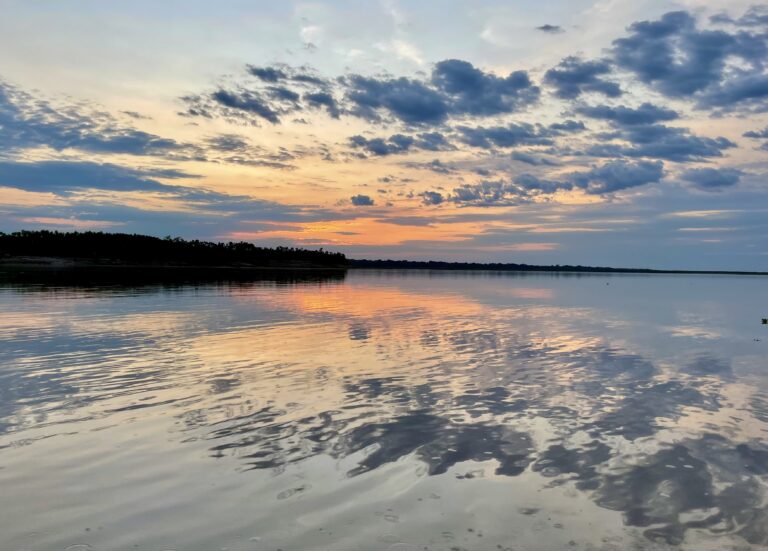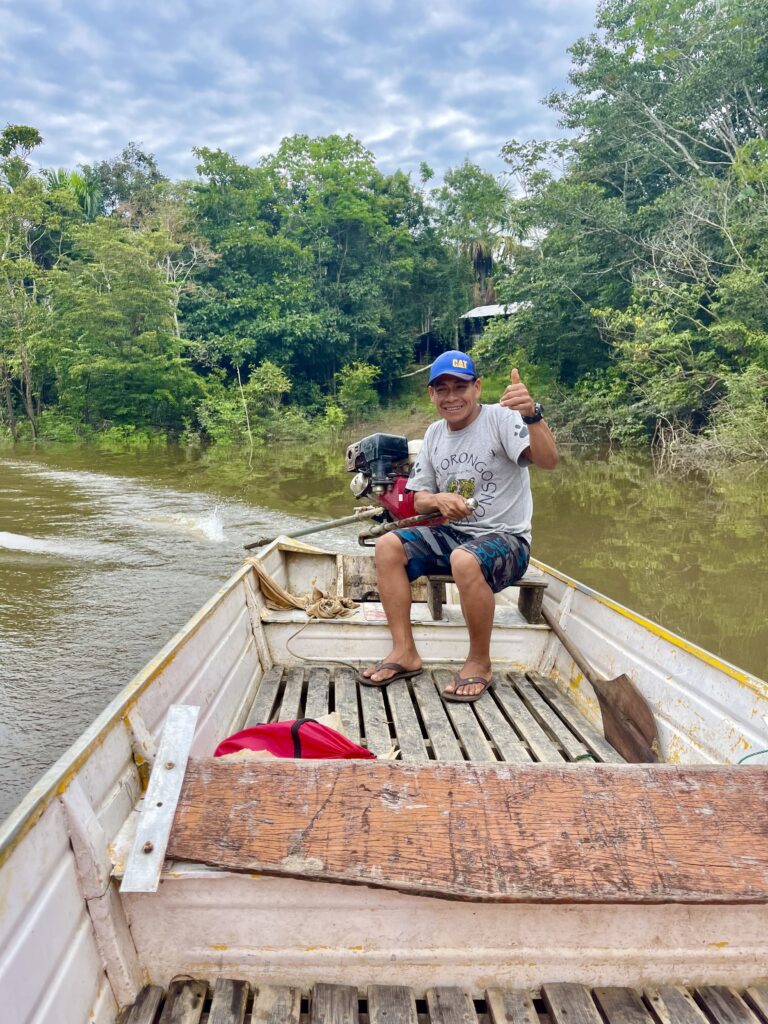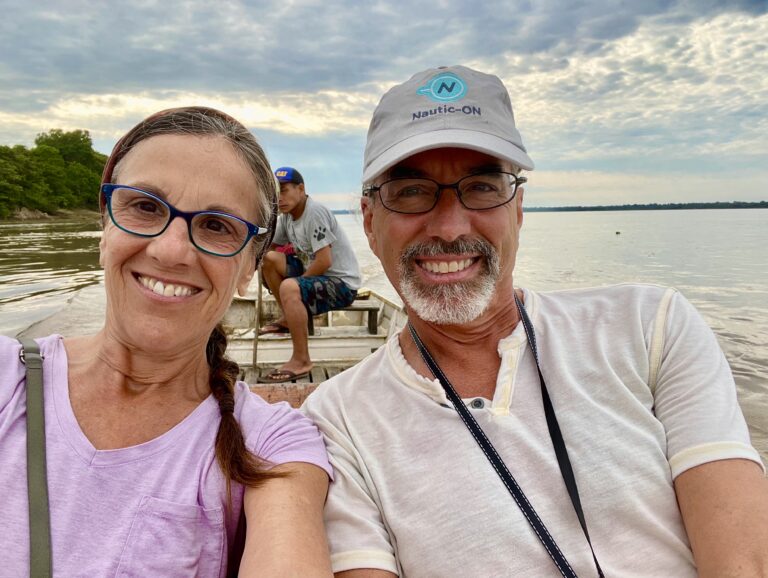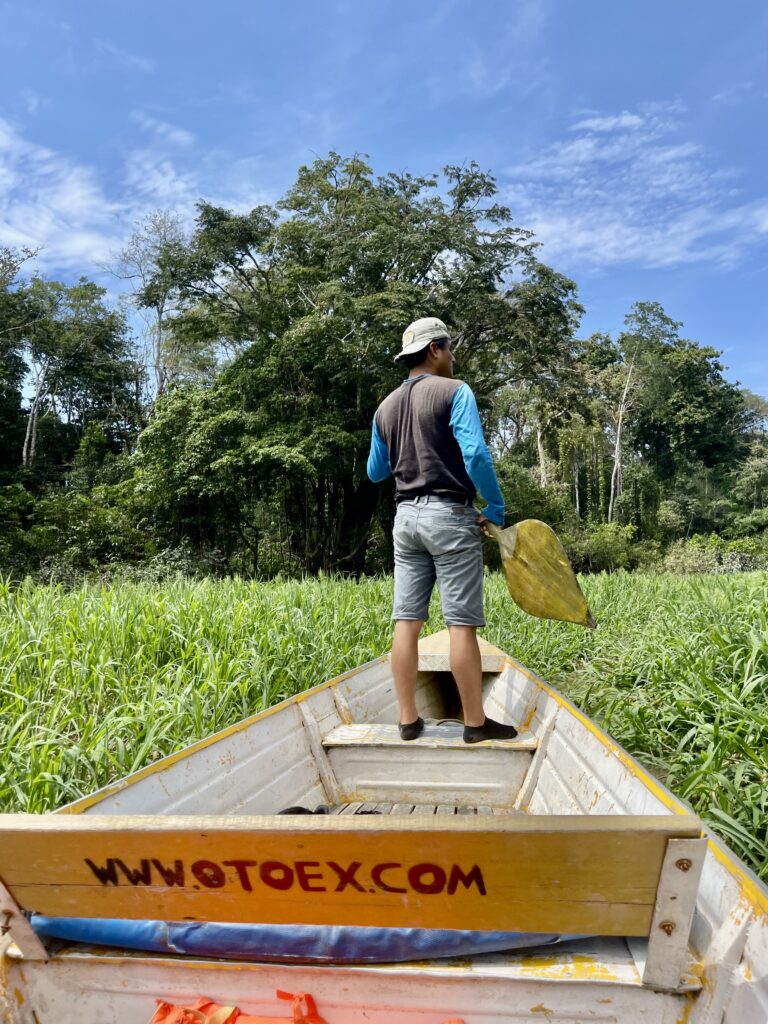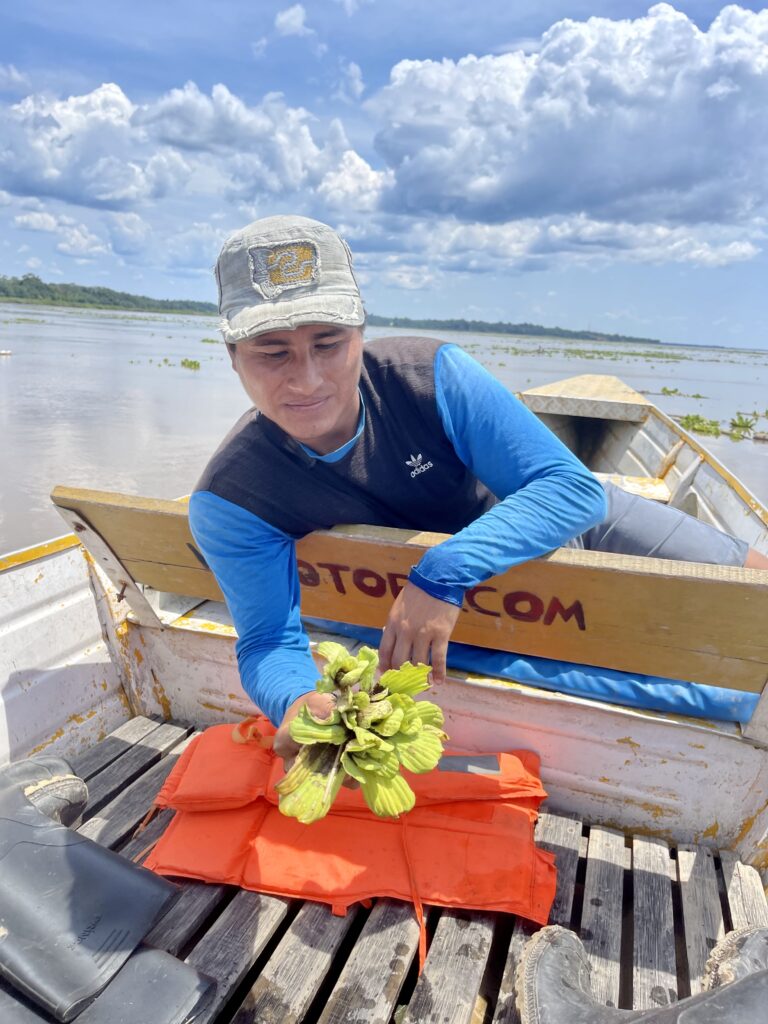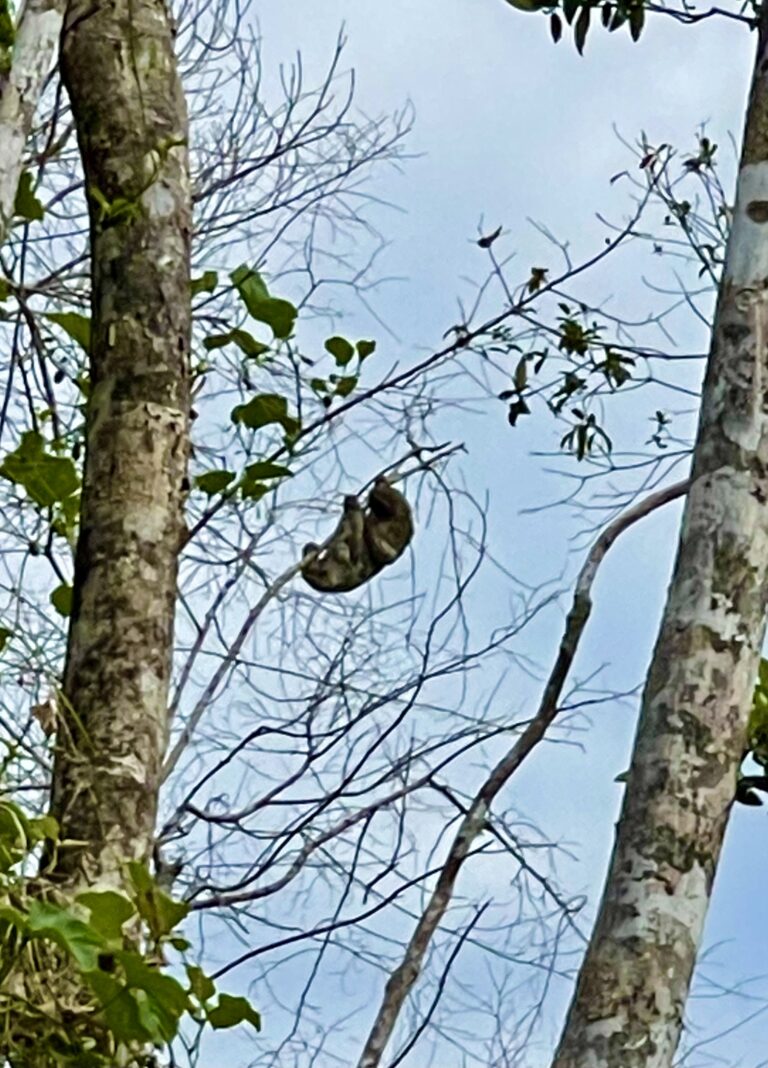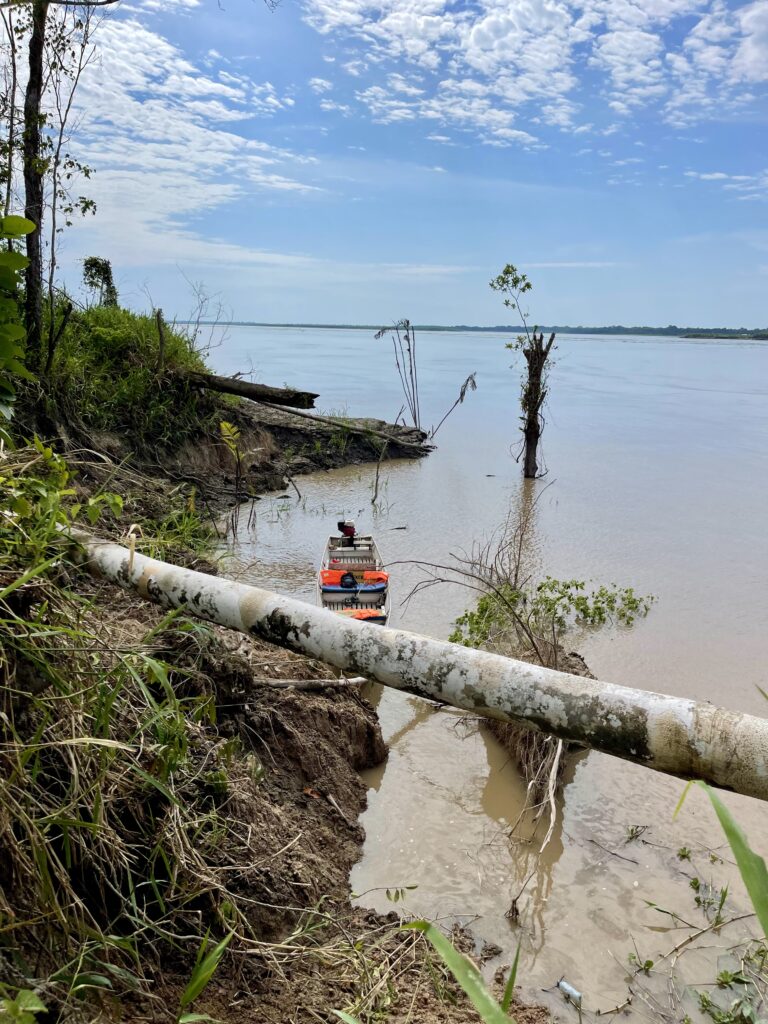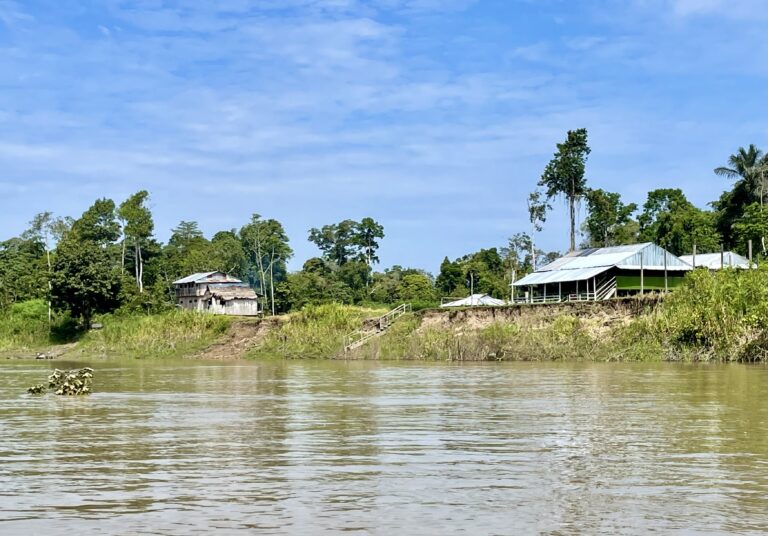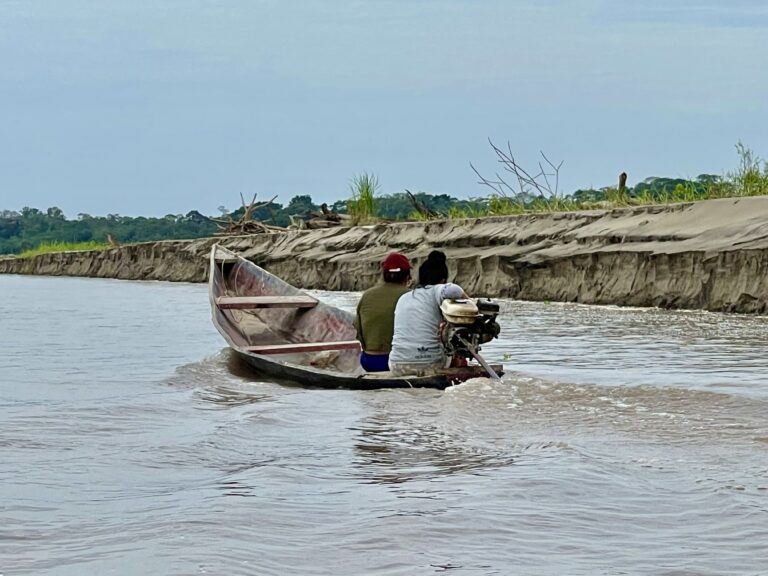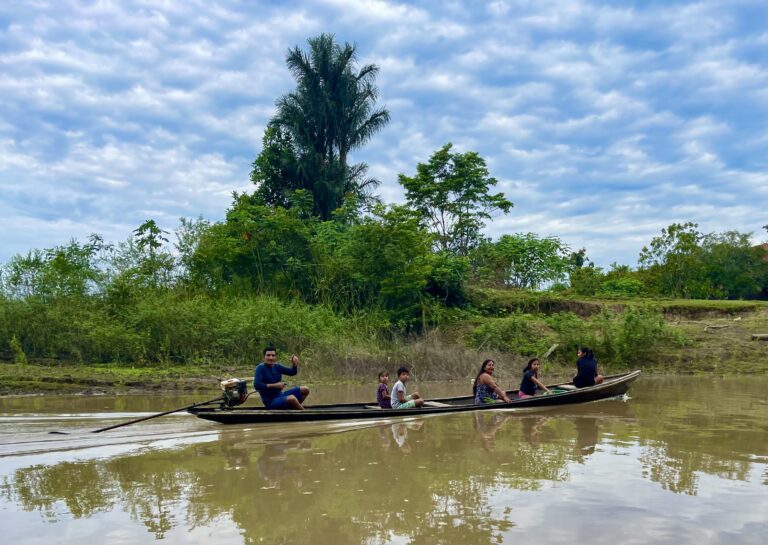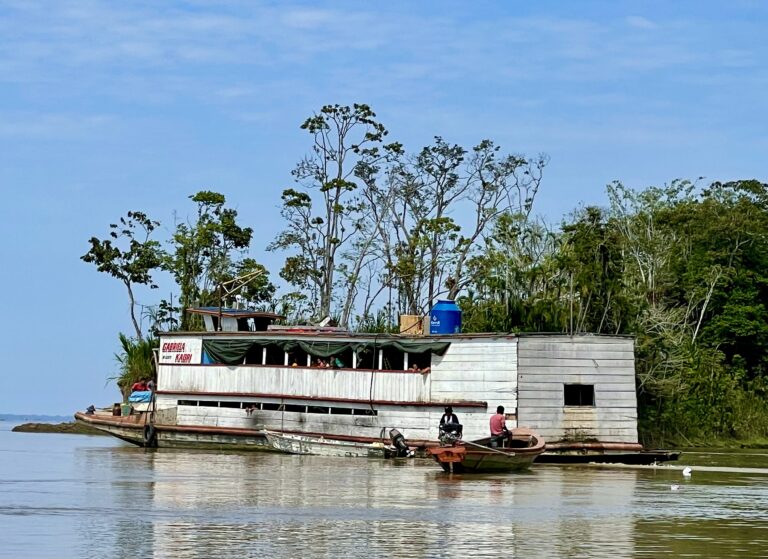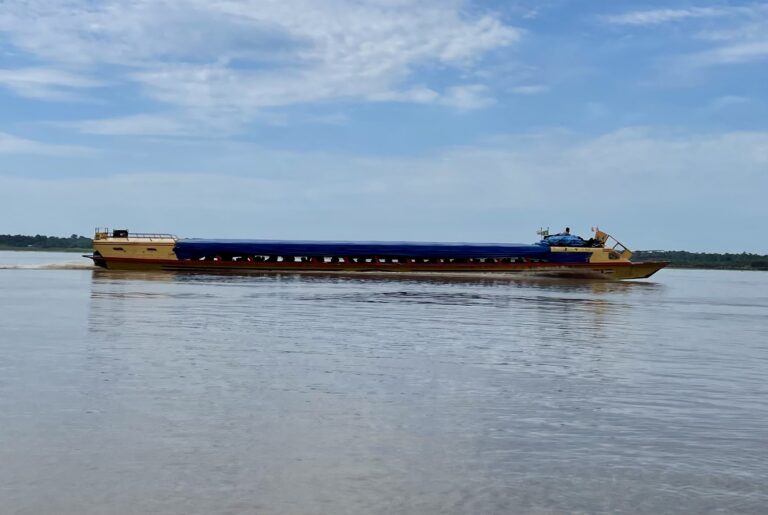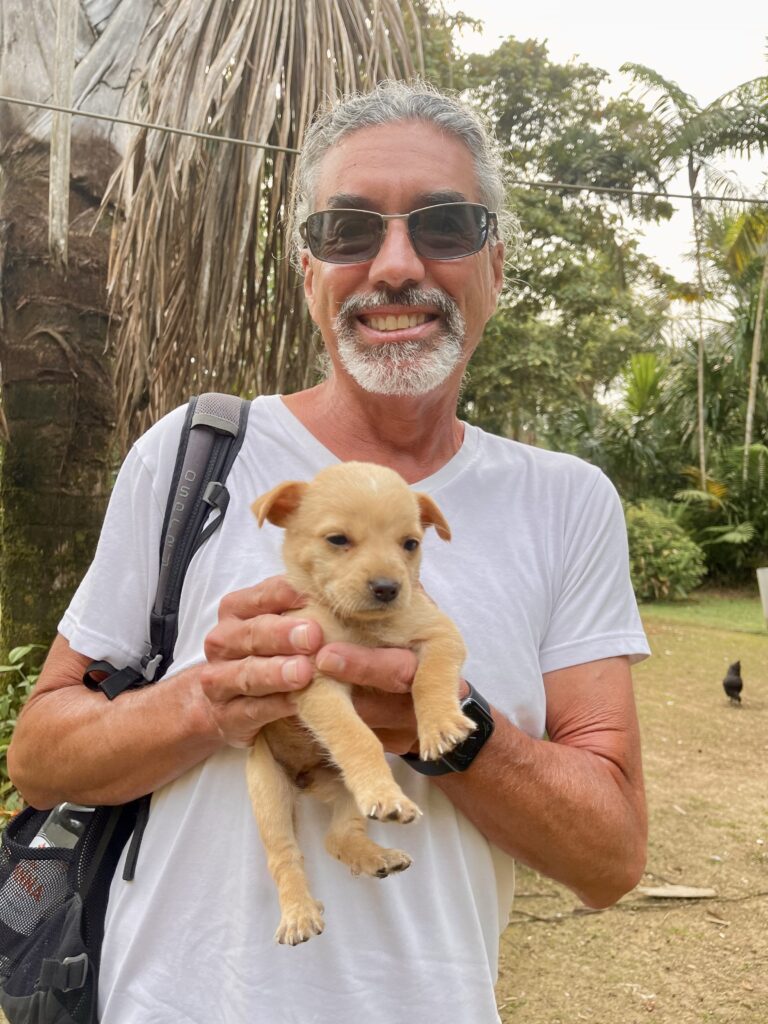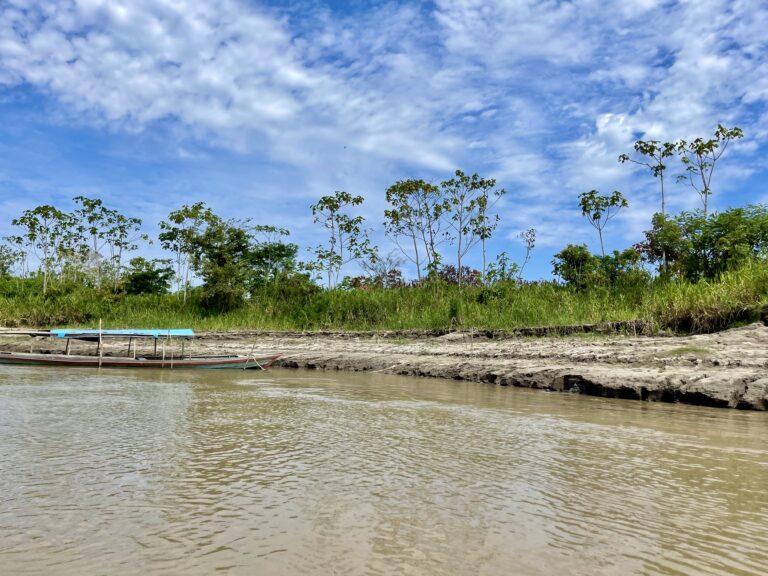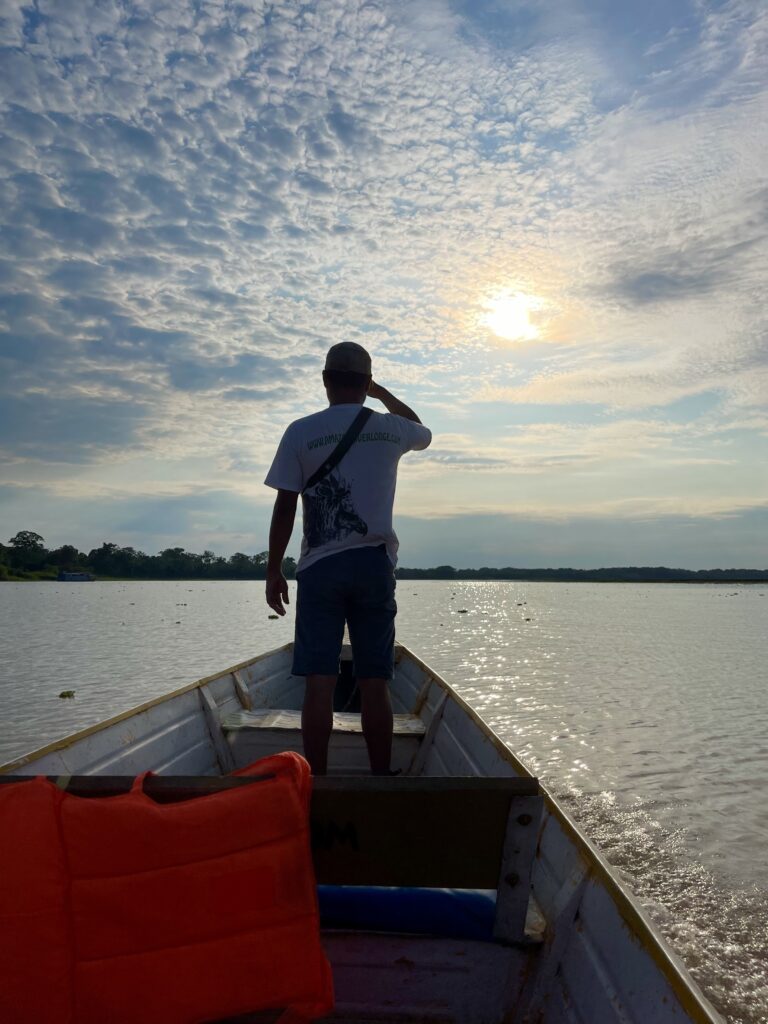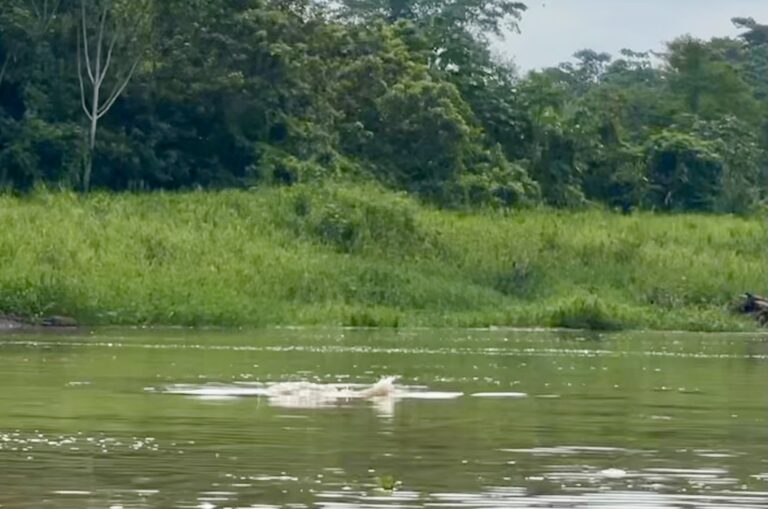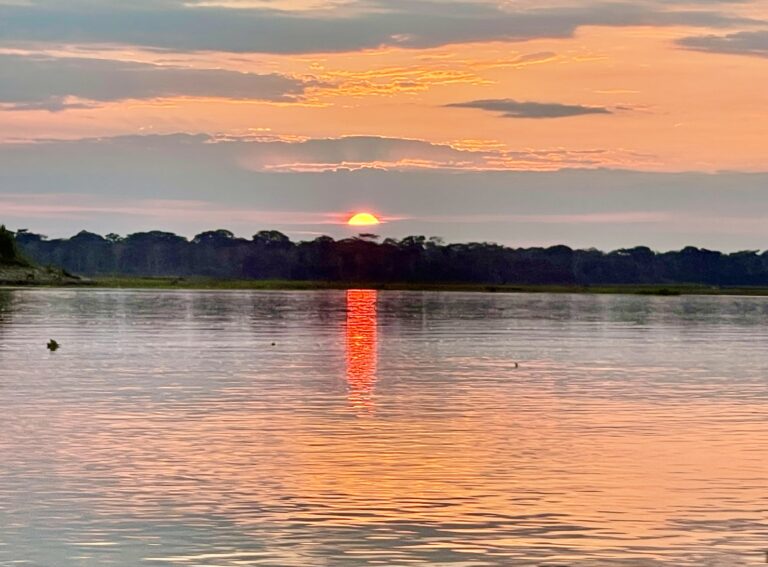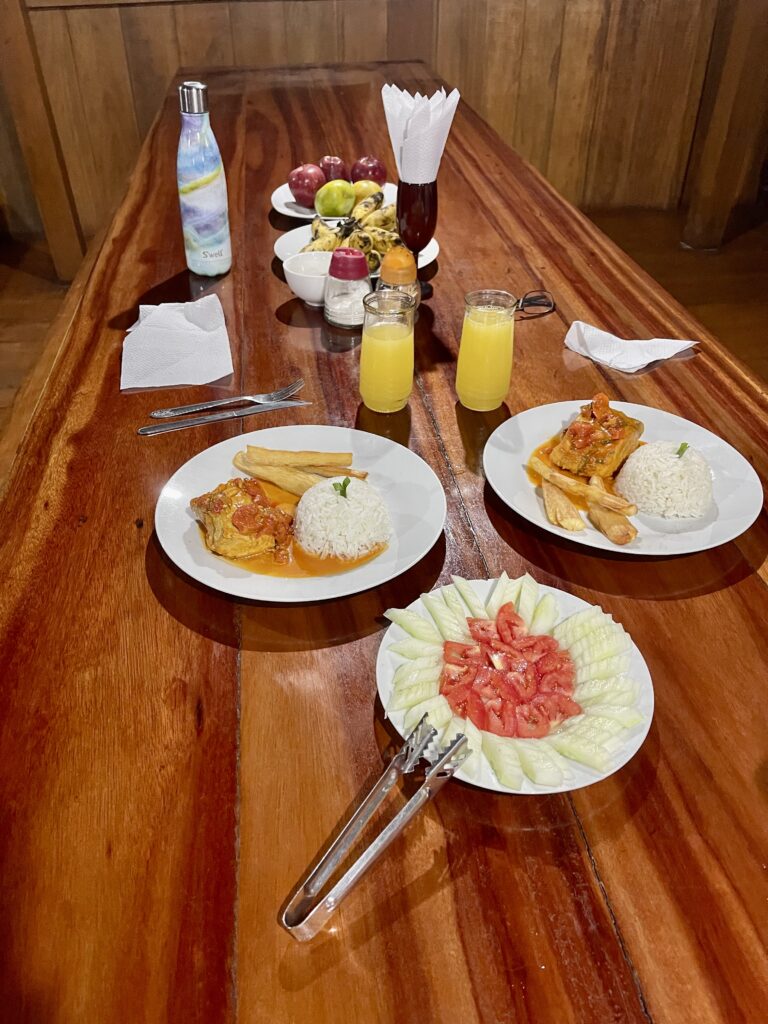February 1, 2022
We slept like rocks for almost 10 hours, finally catching up on sleep. Breakfast was huge and tasty, and I couldn’t see how we could keep eating like this, three times a day. Curiously, unlike other Latin American countries, there were no sweets.
At 8 a.m. we met our guide Jón and his assistant Saul who were taking us by boat to see sloths and monkeys along the riverbank. We loaded up into a small boat called a pecky-pecky because of the sound the engine makes at idle. Peruvians, Jón said, often name things for their sound, like the Victor Diaz bird whose call sounds like VictorDiaz!
Our pecky-pecky was about 25-feet long and four feet wide with a single-cylinder Honda engine turning a crazy 10-feet long drive shaft angled only a few degrees above the water, allowing the captain to pivot the long shaft left and right to steer as well as up and down to avoid shallows and the constant stream of sticks, logs and floating plants that clog the Amazon and its inlets. The air-cooled Honda resembled a giant weed eater and, at speed, it sounded like an old lawn tractor.
On the plus side, when the prop got fouled with grasses or river lettuce, the whole drive shaft pivoted around so the prop sat on the gunwale, making access easy. It was quite ingenious and perfect for the Amazon River and its tributaries which, we soon learned, were often teeming with high grasses and river lettuce.
The only so-called safety gear I noted were some life jackets (some were tied to the seats) and a wooden paddle that was made from a type of heavy wood that sinks if it goes overboard. Jón told us that there could sometimes, maybe might be cell service from a tower a few miles away in the right conditions (but not with our phones) and I wondered again about my decision not to bring our tiny PLB (Personal Locator Beacon). But Saul turned out to be one of the most capable skippers I’d met.
It was hot when we left the muddy dock, but soon we were going about six knots upstream and the wind cooled us a little. Suddenly, we spotted a pink dolphin as he came up for air. He was smaller than other ocean dolphins we’ve seen and with an unusually long beak, but the most unusual aspect was that he was really pink. The pink dolphins of the Amazon River are one of the few freshwater dolphins in the world and are mostly blind, using echolocation to navigate in the murky water.
Farther up the inlet near shore, Saul abruptly stopped the boat and Jón pointed out a three-toed sloth halfway up a tree. We stared at him through binoculars, marveling at his three-inch long claws as he ever-so-slowly descended the tree. Susan learned that trying to videotape a sloth takes a lot of patience.
We pulled the boat ashore and, with Saul leading the way and hacking a path through the dense jungle with his machete, we tried to find the sloth on the ground, where it had been heading. But the sloth had other ideas and slow-motion scrambled back up the tree. Jón spotted him again but Susan and I spent 10 minutes looking before we finally saw him though he was only 20 feet away, so well was he camouflaged.
Back in the boat, we saw a couple more sloths and heard and then saw a troop of small monkeys moving through the trees. As we slowly made our way back toward the lodge, we watched the busy boating scene on the river.
The boats were neither typical recreational boats nor typical commercial ones. Instead, the river was largely a main street for the small villages and homes along its banks. We saw several small fishing craft, often much like our pecky-pecky, and frequently overloaded with passengers.
Jón told us that a large, rundown looking multi-story boat that passed by was the “boat bus” that went up and down the river daily, stopping at each small village en route to Iquitos. Jón explained that even though our boat trip from Iquitos took just two hours (and the upriver return is more like three hours), the slow boat bus takes 6-7 hours to make the same trip. Yet the locals take the bus regularly to sell their goods, including fish and exotic fruits, in Iquitos.
We also saw the ferry that typically travelled between Iquitos and Tres Fronteras—the boat we couldn’t get tickets for. It seemed there were still some ferries running but they were on shortened routes and carrying only Peruvian passengers due to the land/water border closure.
Eventually, we returned to the dock and headed up to the lodge. Lunch was large and tasty and neither of us wanted to eat much because of the heat (and the large breakfast) but we couldn’t help ourselves.
Afterwards, we went back to our cabin and cold-showered (our second of the day) and lied on the bed naked to rest. It was stiflingly hot, about as hot as either of us had ever been. There was not even a breath of wind through the screens and it was easily 100°F inside with high jungle humidity. There were no fans nor electricity to run them even if there were any. Almost immediately after showering we were already sweating.
Eventually, we dozed and woke up drenched in sweat again, feeling sluggish. We were quickly understanding the whole siesta/rest-during-the-hottest-part-of-the-day concept.
A third cold shower woke us somewhat but we immediately were hot again when we put on clothes and walked to meet Jón for the next adventure—searching for more river dolphins. Thank God for the breeze once we got underway. It was supposed to be the wet season but it hadn’t rained in several days. Jón said was quite unusual and he felt the climate had changed significantly since he was a boy. We’d seen plenty of that back home with drought and wildfires.
This time, Saul drove the boat across the wide Amazon River to the other side where Jón said we also might see dolphins. A quarter mile from the riverbank, we stopped and Jón said that where we were floating, a village used to be. Erosion of the sandy river banks forced the entire village a half mile inland as the river grows wider every year.
Back in my sailing days I was famous for taking photos of dolphins at sea that usually resulted in nothing more than a tail slipping under the water so I didn’t expect much in the way of photo ops. Susan tried and similarly failed to capture more than a tail. Pink dolphins, unlike their sea-going cousins, are not very social to humans.
While we watched dolphins appear and quickly disappear, Jón told us the legend of Bufeo, a pink dolphin that is said to take on a human form and visit villages, bringing presents. Feo means ugly in Spanish and the inference was that the six-foot pink creatures seemed to be very much gringo-like. Perhaps a better name for them might be Ugly American.
After wrapping up our dolphin search, Jón invited us to go for a swim in the river. Other than the fact that we’d cool off, there was nothing inviting about such a swim and we declined the invitation. The river was murky brown, there was debris floating here and there and we’d read too much about tropical flesh-eating bacteria and other water creatures we might encounter. Having no such concerns, Jón jumped in.
It was still hot but we could feel a change as dusk approached. As we turned back, the ever-changing colors of the sky and the river as the sun went down behind clouds provided a spectacular sunset.
At dinnertime, Jón told us a group of “herps’ was coming to the lodge soon. Herps are visitors who are into snakes and lizards and wanted to find and photograph fer-de-lance and bushmasters, two of the most venomous snakes in the world, as well as other rare species. There were some of the snakes close by the lodge, Jón said, but not to worry, hardly anyone got bit.
After dinner, we went back to our cabin, now a few degrees cooler, and showered (number four) before going to bed. It was only 8:30, but we felt wiped out from the heat and another large meal.

